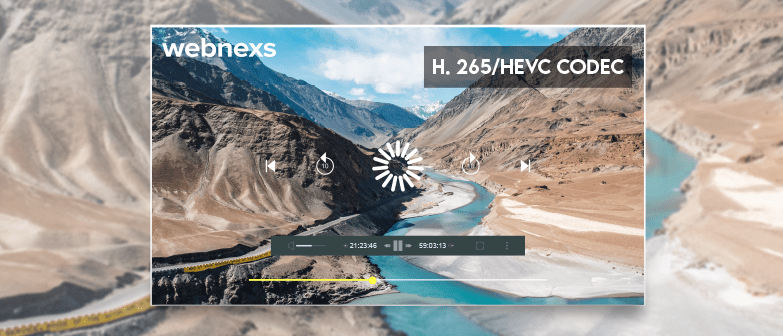Video streaming is becoming more and more popular, with many people turning to VOD (video on demand) services and live streaming for entertainment, education, and business purposes. However, video content is also one of the most data-intensive forms of content, and streaming it requires a lot of bandwidths and data usage. One of the best compression standards available today is H.265 codec.
This is where video compression comes in, allowing video content to be delivered over the internet with fewer data usage and without sacrificing quality.
In this article, we will dive into why H.265/HEVC is the best compression standard for VOD and live streaming, its advantages, how it works, and how to use it for your video content.
What is H.265 Codec?
H.265/HEVC stands for High-Efficiency Video Coding, and it is a compression standard for video content. It was developed by the Joint Collaborative Team on Video Coding (JCT-VC), a group of experts from around the world who worked together to create a more efficient compression standard than the previous H.264/AVC (Advanced Video Coding) standard.
Advantages of using H.265/HEVC for video compression
H.265/HEVC offers several advantages over previous compression standards, including:
- Better compression: H.265/HEVC can achieve the same video quality as H.264/AVC at half the bitrate, meaning that video content can be delivered with less data usage and without sacrificing quality.
- Support for higher resolutions and frame rates: H.265/HEVC supports resolutions up to 8K and frame rates up to 120 frames per second, making it ideal for high-quality video content.
- Improved error resilience: H.265/HEVC can recover from transmission errors more efficiently than previous compression standards, ensuring that the video quality remains high even in poor network conditions.
Read More : A Comparison of H.264 vs H.265 : Which Codec is Right for You?
How does H.265/HEVC work?
H.265/HEVC achieves better compression than previous standards by using more advanced algorithms to analyze and compress video content. It uses a technique called block partitioning, where the video frames are divided into smaller blocks that can be compressed independently. It also uses a technique called intra-frame prediction, where the encoder analyzes each frame and predicts the content of each block based on the content of neighboring blocks, reducing redundancy and achieving better compression.
How to encode and decode H.265/HEVC video
To encode and decode H.265/HEVC video, you will need a hardware or software encoder/decoder that supports the H.265/HEVC standard. Most modern devices and platforms support H.265/HEVC encoding and decoding, including smartphones, tablets, computers, and streaming devices.
To encode H.265/HEVC video, you can use a software encoder such as Handbrake, FFmpeg, or x265, or a hardware encoder such as NVENC or QuickSync. To decode H.265/HEVC video, you can use a software decoder such as VLC, or a hardware decoder such as Intel QuickSync or Nvidia NVDEC.
H.265(HEVC) vs H.264(AVC) Compression
Video compression is reducing the amount of data required to represent a video, in order to make it easier and more efficient to transmit or store. H.265/HEVC and H.264/AVC are two of the most commonly used video codecs for compression, with H.265/HEVC being the more recent standard.
The main difference between H.265/HEVC and H.264/AVC is their compression efficiency. H.265/HEVC can achieve better compression compared to H.264/AVC, meaning that it can deliver the same video quality at a lower bitrate. This is because H.265/HEVC uses more advanced compression techniques such as improved motion compensation, intra prediction, and deblocking filters.

The table above compares the minimum upload speed required for H.264/AVC and H.265/HEVC for various resolutions. It is important to note that these are only minimum recommended upload speeds and may vary based on factors such as frame rate, complexity of the video content, and network conditions.
Advantages of using H.265/HEVC over H.264/AVC
There are several advantages of using H.265/HEVC over H.264/AVC for video compression:
- Better Compression Efficiency: As mentioned earlier, H.265/HEVC offers better compression efficiency compared to H.264/AVC, meaning that it can deliver the same video quality at a lower bitrate. This is especially beneficial for streaming high-quality videos over limited bandwidth networks, as it allows for a smoother viewing experience with less buffering.
- Support for Higher Resolutions and Frame Rates: H.265/HEVC supports higher resolutions and frame rates compared to H.264/AVC, making it ideal for streaming high-quality content such as 4K and 8K videos.
- Improved Image Quality: H.265/HEVC offers improved image quality compared to H.264/AVC, thanks to its advanced compression techniques such as improved motion compensation and intra-prediction.
- Reduced Bandwidth and Storage Requirements: H.265/HEVC’s superior compression efficiency means that it requires less bandwidth and storage space compared to H.264/AVC, which is beneficial for both streaming and storage applications.
- Wide Industry Support: major tech companies and video streaming platforms widely adopted H.265/HEVC, ensuring that it is well-supported and widely compatible.
Overall, the advantages of H.265/HEVC make it an increasingly popular choice for video compression, particularly for high-quality video streaming applications.
Hardware and software support for H.265/HEVC video
Most modern hardware and software supported h.265/HEVC platforms, including:
- Smartphones and tablets: Most modern smartphones and tablets support H.265/HEVC decoding, including Apple iPhones and iPads, and Android devices from Samsung, LG, and others.
- Computers: Most modern computers support H.265/HEVC encoding and decoding, including Windows PCs, Macs, and Linux machines.
- Streaming devices: Most modern streaming devices support H.265/HEVC decoding, including Amazon Fire TV, Roku, and Apple TV.
Using H.265/HEVC for VOD: Best practices
To ensure the best possible quality when using H.265/HEVC for VOD, there are several best practices that should be followed
- Use the right bitrate: While H.265/HEVC can achieve better compression than previous standards, it is still important to use the right bitrate for your video content to ensure that the quality remains high. Use a bitrate calculator to determine the ideal bitrate for your content.
Read more : What is Bitrate, Audio Quality, Audio Codecs, Sample Rate & Bandwidth?
- Use the right encoding settings: Use the right encoding settings for your video content, including the profile, level, and GOP (group of pictures) structure. This will ensure that your video content is encoded correctly and with the best possible quality.
- Use the right container format: H.265/HEVC is typically used with the MP4 or MPEG-TS container formats. Choose the right container format for your video content to ensure compatibility with different devices and platforms.
Using H.265/HEVC for live streaming: Best practices
When using H.265/HEVC for live streaming, there are several best practices to follow that your video content is delivered with the best possible quality:
- Reliable encoder: Hardware or software encoder that supports H.265/HEVC encoding to ensure that your video content is encoded correctly with the best possible quality.
- Right bitrate: Video content to ensure that the quality remains high while minimizing data usage. Use a bitrate calculator to determine the ideal bitrate for your content.
- Adaptive bitrate streaming: Deliver your video content in different resolutions and bitrates depending on the viewer’s network conditions. We will ensure that we deliver your video content with the best possible quality, without buffering or interruptions.
How Webnexs Fits in all of this?
Webnexs has integrated the H.265 codec video compression standard into their video on demand solution, as it is expected to be the leading standard for recording and transcoding hardware and software. This future-oriented approach enables Webnexs to address the streaming needs of the OTT platform and provide scalable solutions to their clients. H.265 compatibility is just one of the many features that make Webnexs a leading video enterprise-grade solution.


